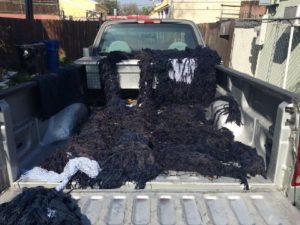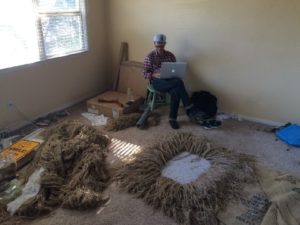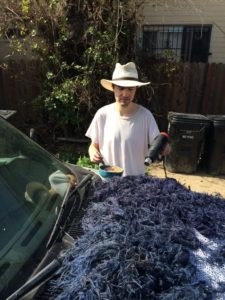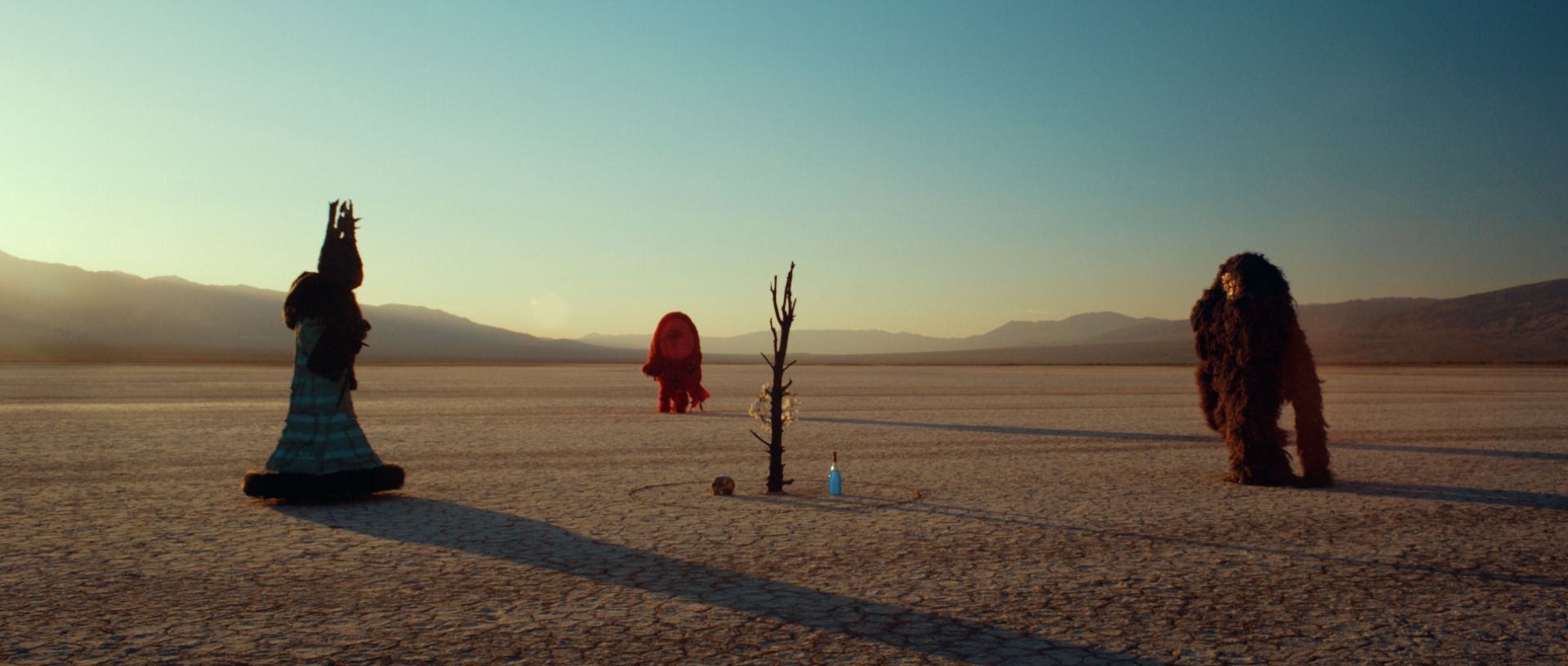A Veteran Battles for His Daughters through Filmmaking
by John Charter
The making of our short creature art film, Remission, is full of disastrous filmmaking war stories — and it all began with an actual war. More on that later. Remission is foremost an “art film,” meant to be interpreted like you would a poem or a painting, with the creature costumes serving as moving art pieces. The concept centers around an unknown soldier in a state of living paralysis or a purgatory loop. Three creatures emerge as outer-body extensions of his war trauma and the ensuing nihilism that he struggles to overcome. Visions of an estranged daughter haunt the man and lead the creatures on a vast, lonely pilgrimage in hopes of restoring their once sacred connection. The symbolism of the film is inspired by the true story of Remission’s co-creator, artist Paul Kaiser. Paul served in the US Navy’s Explosive Ordnance Disposal (EOD) and was held hostage in Iraq for a possible sale to Al Qaeda. The loss of control from this event brought on a deep plunge into an existential crisis and the life he knew fell apart. The film is a reflection of his current mission to emerge from the loop and reconnect with his children.

My greatest hope for the film is that his daughters will see it and one day understand how much their father loves them.
The project was instigated by Paul when he came to me with the “simple” idea of making a short film with creatures for his daughters. I would direct and he would handle all the art — the creature design, production design, and drawings. As we wrote the script together, it became more and more elaborate as neither of us figured out how to say no to one another! As a close friend of Paul’s, what kept me especially motivated was his heartbreaking ongoing battle for joint custody of his daughters. He has not had contact with them in years and tirelessly makes brilliant artwork for them that gets returned in the mail. I admire how Paul owns his own part in this matter, but at this point, there is no justice until he and his girls are reunited. My greatest hope for the film is that his daughters will see it and one day understand how much their father loves them. The choice to include the creatures is an effort to connect with his girls on their level now, if they get to see the film as children. And if they watch it in the future as adults, the intent is that they will comprehend some of the deeper ideas within the film, allowing their inner child to connect with their father’s love.
For six weeks, my house became a creature-making sweatshop.




For six weeks, my house became a creature-making sweatshop. After sketching out designs, Paul was figuring things out on a trial and error basis. Neither of us had any experience with creature filmmaking. My bathtub was converted into a indigo fabric dyeing station for Marquis d’Sea, the most labor intensive creature. His fur was made from individually pulled strands of used burlap coffee bags that gave him a naturally tattered and worn texture. Paul was inspired by the ghillie suits he made while serving as a US Army Infantry Scout. The multiple submarine eyes are restless and always recalling the battles he cannot unsee. On our first day of filming with Marquis d’Sea at a beach in Malibu, our actor struggled to hold up the mask for extended takes as it weighed almost 50 pounds!




None of this footage made the cut. Still, we are grateful for this initial failure as the redesigned mask was much more actor-friendly and looked even better without the heavy horns. As Paul watched costume-making videos from Henson Studios, he was constantly tinkering with the engineering of creations to make them lighter and more robust. Keeping the creatures “camera ready” was especially high maintenance due to damage from the harsh environments and lack of ideal transportation. Paul’s open fantasy about “burning these costumes after we finish” is likely what kept him from going insane.

When we began casting I doubted that any actor would be excited about wearing a heavy costume that covers their face. First we attempted to work with non-actors and it was a struggle. Then I did a “Hail Mary” post on LA Casting. “Anyone new in town who is looking for adventure?” To our surprise, pro creature-actor Alan Maxson responded and through him we discovered a vibrant LA Creature-acting community. As we filmed new scenes we could immediately see a huge difference with fluid and believable body movements. Our pro creature-actors were able to pull off some tricky maneuvering, including one shot where they bow and offer gifts with paws that are not dexterous.
My longtime collaborator Rainer Lipski slummed it as our cinematographer, especially compared to his usual work on features and commercials. We camped the whole time, but that was often one star higher than the nearest meth-den desert motel. Rainer was limited to a basic DSLR video kit with the exception of the Ronin stabilizer and a set of old Leica R-Series lenses. My 5D Mark iii camera was modified with a companion firmware known as Magic Lantern, which allowed us to capture beautiful RAW image sequences instead of low quality H264 video. Rainer made my “hacked” 5D sing in the beautiful Southern California light and then Nick Sanders, our favorite Colorist, took it to the next level.

The downside to Magic Lantern is huge file sizes, a cumbersome workflow, and choppy playback. However, the forced limitation of not having unlimited takes was a benefit — this heightened our focus on set, just like when you shoot on film. Magic Lantern also has resolution limits, but Rainer and I feel that the 4K plus trend is overrated as a measure of image quality. Our Camera Assistant Marcello Peschiera generously offered his RED Camera for free, but I politely declined because I prefer the photographic feel of the Canon sensor with Magic Lantern. He mentioned on our 128 degree Fahrenheit shoot day that his RED would have overheated. Another benefit of the 5D is that it can take a beating.

We aimed to compose each shot as if it could be a standalone painting. An extravagantly inefficient schedule was created in order to only shoot during perfect magic hour lighting conditions. Each morning we woke up before sunrise and filmed one setup. Then, no filming until late afternoon magic hour. In between, we would travel hundreds of miles looking for any terrain that might be even better than the locations we scouted a few weeks prior. This painstaking approach resulted in 20 shooting days and 3 pick-up days for what will be a 7-minute short film. Maybe that’s sensible since our nearest comparison would be a nature doc — with laughing hyenas that do not want to be filmed!

The shoot was a war against nature — the blazing desert sun, snakes, and off-road driving to remote areas without cellphone service. One evening, a rattlesnake slithered into our camp and could not be scared away. As it got dangerously close, Paul’s Special Ops instincts kicked in as he grabbed a shovel and chopped off the snake’s head. We only had cots and no tents, but the desert stars were our consolation for having to keep one ear open for rattles.

Bad weather, safety concerns, wardrobe malfunctions, flat tires, and getting lost all led to lost days and huge delays. The biggest blow was when we lost the location that the entire script was originally based around. Our crew had driven 6 hours from LA with a weeks-worth of rented gear and the owner of the location simply changed her mind. We could not afford a suitable location replacement so we were shut down for over a year as I worked on corporate videos and saved up for the remaining costs. Altogether, our total damages (or total budget) was $20K. This may seem excessive for a short film, especially since we were mostly volunteers, but most of our budget went to costume design materials, gas, and rented SUVs. Considering all the unique environments we used that were not conveniently near each another, our budget could be viewed as barebones.


Filming was not too awful for Rainer and me, but Paul was put through hell wearing the creature costumes during our shoot in Death Valley. When he took off a mask, he would be entirely soaked in sweat, joking that he had nobody to blame but himself. Because this film is dedicated to his girls, he would not make any compromises for comfort. In later shoots, he walked barefoot through a burnt forest and sank into the ocean’s icy cold depths without a wetsuit. Subconsciously, he was affirming that he would do anything for them. In the film, the creatures do the same. We were creating the meditative tone of a biblical pilgrimage in which creatures travel great distances across desolate landscapes to evoke a sense of loneliness, longing, and commitment at any cost. The creatures, who are an extension of Paul, would travel to the end of the earth to make their offering.

On our last day of creature filming, we were at a burnt forest in Santa Clarita. Javier Santoveña was acting as Artemis, the creature with the jagged crown and a turquoise and black striped dress. We were in position for the final shot of the day — AKA the martini shot. Out of nowhere, on a calm and cloudless evening, a giant thundercloud began to roll over the hills. We scrambled up the mountain for a better angle. As the camera pulled back on the slider, the lightning struck perfectly on either side of the creature mask. My eyes were on the verge of tears as we witnessed this miracle. The movie Gods were smiling down on us.
This project from hell (or heaven, depending on the day) is in the final steps of post-production. We are forever grateful to our solid cast and crew who made it all possible, and they can be found in the description of our Vimeo teaser. We did audience testing with our rough cut and won Best Experimental Film at Evolution Mallorca International Film Festival, which was the best festival I’ve ever experienced.

At a gallery exhibit of the film, our co-producer Sarita Choy, Paul, and I were shocked that 5 year-olds were some of our biggest fans. Some dragged their parents back daily and sat through multiple viewings as if hypnotized. Through these test screenings, we discovered areas for improvement and are currently completing an animated component.
When I said “disaster” earlier, I meant in the tradition of films that are borderline too elaborate for the resources at hand. For any filmmaker who feels doomed, watch The Wizard of Oz DVD special features. The film was shutdown multiple times with four director replacements and awful setbacks such as the Wicked Witch catching on fire. Plus, they went over budget by one million dollars in 1939. The main director Victor Fleming once said, “Don’t get excited. Obstacles make for a better picture.” I believe this was the case for us.

John Charter is an LA based director who made the creature art film Remission with artist Paul Kaiser. To learn more about the film, visit remissionfilm.com.

